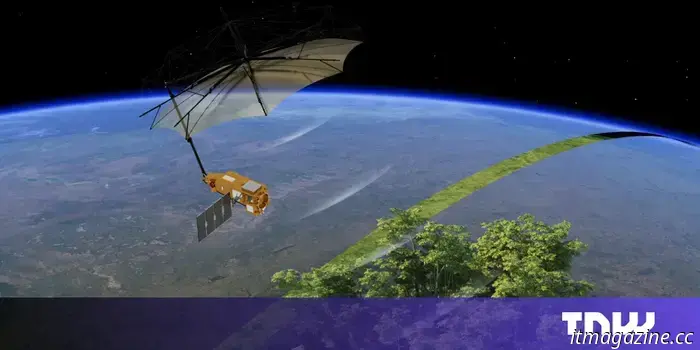
A massive radar 'umbrella' has been launched into space with the goal of revolutionizing climate science.
The European Space Agency (ESA) has successfully launched its Biomass satellite into space using a Vega-C rocket. The launch occurred today at 11:15 (CEST) from Kourou, French Guiana, which serves as Europe’s spaceport.
Now in orbit, this innovative satellite will deploy a radar antenna resembling a large umbrella in space. Created by US defense contractor L3 Harris, the antenna is so complex that it will require nine days to fully unfold once in orbit.
The purpose of the umbrella is to send radar pulses from a P-band radar instrument located on the satellite down to the forests below. This radar operates with long wavelengths capable of penetrating dense canopies to reach the woody structures beneath, where the majority of a forest's carbon resides. Developed by Airbus, this satellite represents the first-ever P-band radar sent into space.
When the radar waves encounter the Earth's surface, they bounce back. The umbrella-shaped antenna captures these returning signals and redirects them to the satellite. The onboard systems then process this data to generate detailed 3D maps of global biomass, akin to an MRI scan for forests.
By illuminating the composition of the world's biomass, which consists of an intricate network of leaves, stems, branches, and trunks, this probe aims to achieve the most detailed measurements of forest carbon ever captured from space, potentially transforming climate science.
Forests, often referred to as the planet's “green lungs,” remove approximately 8 billion tonnes of carbon dioxide from the atmosphere annually. However, when trees are cut down or harmed, they release stored carbon back into the atmosphere, accelerating climate change. Monitoring the movement of carbon in and out of forests is essential for scientists to comprehend and anticipate climate patterns.
The satellite is engineered to assess biomass, height, and carbon content with unparalleled accuracy. This capability could assist scientists in more effectively tracking deforestation and forest growth, while also elucidating the role of biomass in the carbon cycle. In addition to forest data, the probe can also chart subsurface geology in deserts, ice sheet structures, and forest floor topography, providing a fresh outlook on Earth’s ecosystems.

Other articles
 7 top TV shows of 2025 to date
If you're in search of something fresh and thrilling to watch at the moment, here are the seven top TV shows of 2025 so far.
7 top TV shows of 2025 to date
If you're in search of something fresh and thrilling to watch at the moment, here are the seven top TV shows of 2025 so far.
 The Nakamichi Dragon 11.4.6 surround sound system is available with a $1,200 price reduction.
Currently, the Nakamichi Dragon 11.4.6 is available at a reduced price of $2,800 from various retailers. Give your living room the surround sound experience it has always needed.
The Nakamichi Dragon 11.4.6 surround sound system is available with a $1,200 price reduction.
Currently, the Nakamichi Dragon 11.4.6 is available at a reduced price of $2,800 from various retailers. Give your living room the surround sound experience it has always needed.
 Roblox is set to release a complimentary ‘Karate Kid Training Simulator’ featuring exclusive rewards.
Gamefam and Sony Pictures are introducing a Karate Kid simulation game within Roblox to promote Karate Kid: Legends.
Roblox is set to release a complimentary ‘Karate Kid Training Simulator’ featuring exclusive rewards.
Gamefam and Sony Pictures are introducing a Karate Kid simulation game within Roblox to promote Karate Kid: Legends.
 Splitgate 2 reveals an open beta and an unlimited number of maps.
If you didn't get to participate in Splitgate 2's open alpha test, you'll have another opportunity to play the game shortly.
Splitgate 2 reveals an open beta and an unlimited number of maps.
If you didn't get to participate in Splitgate 2's open alpha test, you'll have another opportunity to play the game shortly.
 Dutch neobank Bunq introduces cryptocurrency trading service.
Dutch neobank Bunq has launched a cryptocurrency trading service today, offering access to more than 300 cryptocurrencies, including Bitcoin, Ethereum, and Solana.
Dutch neobank Bunq introduces cryptocurrency trading service.
Dutch neobank Bunq has launched a cryptocurrency trading service today, offering access to more than 300 cryptocurrencies, including Bitcoin, Ethereum, and Solana.
 Good luck getting to sleep tonight after you see the Weapons trailer.
In the initial trailer for Weapons, writer-director Zach Cregger creates a unique horror experience that is sure to haunt your dreams.
Good luck getting to sleep tonight after you see the Weapons trailer.
In the initial trailer for Weapons, writer-director Zach Cregger creates a unique horror experience that is sure to haunt your dreams.
A massive radar 'umbrella' has been launched into space with the goal of revolutionizing climate science.
The European Space Agency (ESA) has launched its Biomass satellite into orbit, and it has the potential to transform our understanding of carbon.
